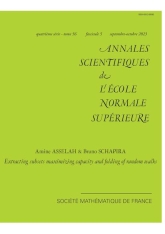Sous-ensembles de capacité maximale et marches aléatoires
Extracting subsets maximizing capacity and folding of random walks

- Consulter un extrait
- Année : 2023
- Fascicule : 5
- Tome : 56
- Format : Électronique
- Langue de l'ouvrage :
Anglais - Class. Math. : 60F05, 60G50
- Pages : 1565-1582
- DOI : 10.24033/asens.2561
Nous montrons que de toute partie finie de $Z^d$, en dimension trois et plus, on peut extraire un sous-ensemble dont la capacité et le volume sont du même ordre de grandeur que la capacité de la partie initiale. Cette observation nous permet d'obtenir, sous des hypothèses optimales, des estimations de la probabilité qu'une marche aléatoire recouvre uniformément un ensemble fini. Enfin, nous caractérisons certains événements de repliement de la marche. Par exemple, lorsque l'on sait qu'une marche aléatoire se replie pour produire une densité d'occupation atypiquement grande, alors la région de repliement a typiquement la forme d'une boule, au sens où sa capacité est du même ordre de grandeur que celle d'une boule.
temps locaux, capacité, marche aléatoire
Électronique
Prix public
20.00 €
Prix membre
14.00 €
Quantité

